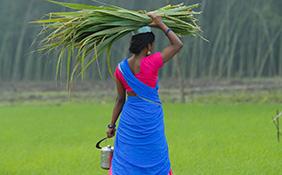A Portrait of Women's Empowerment in India
Empowering women to participate in economic and social life across sectors is essential to build back stronger economies in the wake of the Covid-19 pandemic and to achieve the fifth Sustainable Development Goal (SDG 5) which puts priority on gender equality and the empowerment of all women and girls by 2030. In India, this is especially relevant as social norms and attitudes around the roles and choices of women remain prevalent, amidst high levels of spousal violence, reported at 29.3% of married women between 18 and 49 years of age, as per the recent National Family Health Survey (NFHS-5) for the period 2019-21.
The NFHS-5 dataset is a rich source of health metrics, and also sheds light on the government’s flagship schemes relevant to a decent quality of life in India. Significant progress is reflected for the period 2015-16 to 2019-21, and household electrification rose from 88% to 96.8%, households using clean cooking fuel increased from 43.8% to 58.6%, access to improved drinking water sources increased from 94.4% to 96%, and household use of improved sanitation facilities shot up from 48.5% to 70.2%. As important markers of a better life, critical basic infrastructure thus forms the backbone for equitable human development across the gender divide. Yet, the data also reveals cleavages in the gendered burden of accessing essential services and their outcomes in key domains of development such as health and education, followed by markers of upward mobility like mobile use, internet, assets and independence in decision making. From this, we can paint a portrait of women’s empowerment in the country, to build back better in the wake of the Covid-19 pandemic.
Womens’ Empowerment subsumes improvements made in the spheres of social, political, educational, health and economic status. One of the most crucial determinants of empowerment is education. The NFHS-5 reveals that as of 2019-21, women are less literate than men aged 15-49 by about 13%. Females above the age of six that have ever attended school have marginally increased from 68.8% to 71.8%, and only 41% women aged 15-49 have completed ten or more years of schooling compared to 50.2% men. Achieving gender parity in education remains an urgent policy priority going forward.
The second sphere of empowerment is economic in nature, including assets, finance and jobs. As per the data, 43.3% of women aged 15-49 own a house or land alone or jointly with others in 2019-21, compared to 38.4% in 2015-16. In a significant improvement of more than 25% from the previous round, 77.4% of women now have bank or savings accounts which they themselves use. Yet, the data on jobs continues to be far from encouraging. Amidst a boom in the population of working age, the female labour force participation rate has been under duress, at 20% as per the Periodic Labour Force Survey compared to 50.6% for men. (PLFS 2019-20)
Participation in the labour force amongst females is often influenced by the burden of unpaid domestic work and child care within marriage. According to the NFHS-5, a significant 23.3% of women aged 20-24 are married before the legal age (a reduction in 3.5% from 2015-16), while a lesser but significant 17.7% of men aged 25-29 are married before the legal age. While the overall fertility rate has fallen, adolescent fertility among women aged 15-19 remains unabashedly high at 43% which may be an important marker of why women are not entering or staying in the workforce.
Additionally, only 13.6% of children under the age of five attended pre-primary school in 2019-20, thereby likely increasing the burden of care on women. Other aspects of empowerment lie in the socio-political space, and manifest in the intersection of voice and decision making. A significant 88.7% of married women usually participate in decisions about their own health care, making major household purchases and visits to family or relatives. This is very encouraging, and sets the stage for further in the area.
Newer spaces of expression and virtual commons include the internet, and the data on this is startling. There is a stark difference in gendered access to the internet, wherein 33% of women report they have ever accessed the internet, compared to 57% of their male counterparts. This is especially relevant to disseminating scheme benefits and updates via mobiles which is increasingly being touted as a one-size-fits all solution amidst increasing mobile penetration in the country. It is important to temper these expectations against the facts- only 54% women in the country have a mobile phone which they themselves use, compared to 45.9% in 2015-16.
Learning from this data, we need to re-design existing interventions to strengthen their outreach and impact, and facilitate newer forms of engagement where gaps exist. For example, the National Rural Livelihoods Programme harnesses the power of mobile phones to disseminate key messages and updates to SHG members, however, as the NFHS data reveals that only about half of the women in the country own a phone that they use, interventions need to be strengthened for those who don’t. Similarly, as spousal violence, underage marriage and adolescent fertility remain high, a large policy thrust may be placed on harnessing the power of informal networks to change pervasive attitudes around women within IEC budgets, starting with changing attitudes among those responsible for scheme delivery. Flagship skill development schemes and entrepreneurship support may be re-oriented with renewed vigor to incentivize women to work, alongside structural institutional policies for child-friendly work spaces in formal and informal settings. In the domain of education, extra attention may be given to institutional access to menstrual hygiene management, and in enabling smoother transitions to higher education. Empowerment is a journey in progress, and while we have come a long way, we certainly have miles to go before we sleep.
 GOVERNMENT OF INDIA
GOVERNMENT OF INDIA
